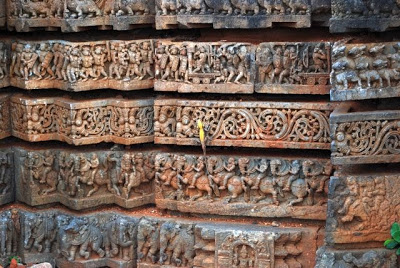
The villager gives me a vacant look when I ask him the route to Dwarasamudra, the 11th century capital of the Hoysalas. I try again and this time I add Hoysala capital and temple as well. He responds with a toothless grin and rapidly gives directions in Kannada to my driver.
My search for Dwarasamudra however takes me to the portals of a famous tourist site, the 12th century Hoysaleshwar temple in modern day Halebeed .To the many tourists here, Halebeed is the capital , but Dwarasamudra is still alive in the ruins scattered in the old village
I walk beyond the bylanes of the temple into the old village where Dwarasamudra comes alive in the ruins . An inscription here speaks of a battle fought here against the Kalachuriyas by Veera Ballalla II. A few tourists go boating on the lake, which was once the foundation of Dwarasamudra, which means Entry by Ocean.
A rustic calls me over to see another inscription .It says the Hoysalas were ruling from Velapuri or Belur from the banks of the Yagachi river. When Vinayaditya shifted to Dwarasamudra in the 11th century ,he built a canal to channelize water from Yagachi to the new capital. A tank was built and the Hoysaleshwar temple was later constructed on its bank. “ And then , it was renamed as Halebeedu, meaning old abode, “ explains the villager as we walk together to see the ruins.
With the Bennegudda hill looking down on them, the remnants of the old city stood silently. A fortified palace and a pedestals of temples lie scattered. There is a Linga with some headless sculptures and some broken friezes .This was the capital of a dynasty that once defeated the Chola, Chalukyas , Kadambas and Kalachuryas before being destroyed by internal strile and ravaged by the Muslim invaders in the 14th century.
I sit on the steps of the ruined temple and read about the saga about the dynasty’s end. Somewhere in the middle of the 13th century, the Hoysala kingdom was divided between two brothers, Narasimha III who ruled from Dwarasamudra and Ramanatha from Kannanur. The brothers fought over Dwarasamudra even as Narasimha III’s son Veera Ballalla III came to the throne. He eventually became the last king of the dynasty as the final blow came in the form of Malik kafur, a general of Alauddin Khilji who invaded south in the 14th century.
The invaders forced Ballalla III to submit and looted him of 312 elephants, 20,000 horses besides jewellery. Dwarasamudra was plundered as Ballalla fled to Belur. A few years later, the king returned and attempted to rebuild Dwarsamudra , but the Muslim onslaught continued. As Dwarasamudra was further destroyed, the king fled to Tiruvannamalai , but died in Madurai while fighting the invaders. It is said the cruel blow came when “ the captured king was slain and skinned , his skin was stuffed with straw and hung from the top of the walls from Madurai. “ Ibn Battuta, the Morroccon traveler who was in the court of Muhammad bin Tughluq, the reigning Sultan at the time records this as I put the book with a heavy heart.
Outside the air became solemn as twilight set in. As the dynasty ended , Dwarasamudra disappeared into the dusty annals of history . Halebeedu took over from Dwarasamudra and found its place in another map – the tourist’s agenda. The lights came up at the Hoysaleswara temple as the last set of tourists posed for a picture against the monument and grabbed a piece of history unknowingly with them. The sun may have set on the dynasty a 1000 years ago, but they made sure they left their glory behind in the temples they have built.
This was published in The Hindu, Metro Plus in my column, Inside Story. Coming up next – what to see in Dwarsamudra besides the famous Hoysaleshwara temple in Halebeedu.

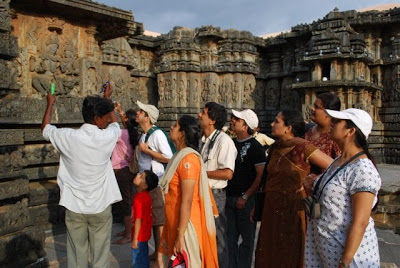
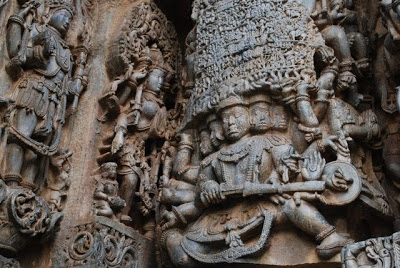
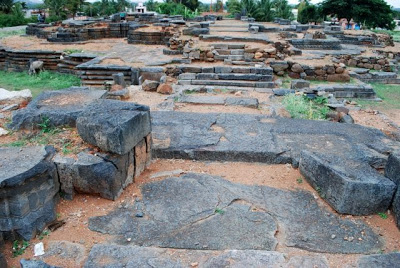
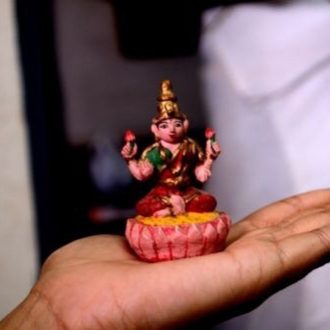
I’ve been reading info on your site for quite some time now
History books can take a back seat…thats a hell lot of info…good work.
Although I have not travelled in that part of the country, I knew about Dwarasamudra, perhaps through your own writings. Thanks for the interesting information.
Superb history lesson :)) very unlike the usual…. I think you and Arun can write a book on the architecture / history of the Hoysalas!
Fascinating account.
Astonishing history amazing culture and civilization! Great photos.
Wonderful post 🙂 I always loved history.
Great to know an interesting part of history. oh! the king’s end was harsh of the story!
It’s nice to know that you have a very interesting blog here…With a historical facts about the place, I find it very informative and I’ve learned so much out of this article.
Buy WoW Hunter Accounts
Hi Lakshmi,
Nice information.
Just to add mythological info on the pics in your post,
The first picture (pic has the top portion of the sculpture cut off) is a depiction of:
Ravana lifting the kailasa when he gets upset with Lord Shiva for not giving him atmalinga..
Shiva parvathi (this is the top most part of the sculpture, which is cropped in the pic) have lost balance..
Shiva gets angry and pushes the weight of kailasa on him..
Unable to withstand the pressure, ravana’s legs go in awkward position.
Second picture is 5layers around the temple which depicts,
(from base)
first layer: elephants – symbol of strength
Second layer: horse – symbol of speed
third layer: flowers – symbol of beauty
fourth layer: events from the two epics, ramayana and mahabharatha
fifth layer: makara animal – mythological creature found in all hoysala temples.(in bangalore, ragigudda temple has the makara animal above the gharbagudi entrance)
Recently I visited Belur and Halebeed and it is one of the best temples built by our indian kings but there is no proper road from belur to halebeed concern authorities should look into this area.
Sir, I don’t know what quality road you are expecting. There is a proper road Belur to Halebeedu.
It’s not a 4 lane toll road for sure. But it’s okay for the current volume of traffic.